As I wound up the quiet roads of Aragon, I stumbled into Aínsa, a village perched high above the Spanish Pyrenees that feels like it hit pause centuries ago. Those old stone streets and the medieval walls immediately pulled me into a different era. Aínsa’s Plaza Mayor hooked me instantly—an ancient square wrapped in arcades, watched over by a Romanesque church tower that’s seen it all.

Exploring Aínsa felt like wandering through a living museum, but honestly, it’s the town’s energy that really made its history feel real. Locals gathered in cafes under the arches, and the views stretched over Ordesa and Monte Perdido Natural Park. If you want medieval Spain without elbowing through crowds, this hilltop village is a solid bet.
Discovering Aínsa: A Journey Through Medieval Aragon
Right away, Aínsa gave off a vibe totally unlike other Spanish towns I’d seen. It sits on a ridge between two rivers, blending deep history with those jaw-dropping Pyrenees views.
Stepping Back in Time
As I walked Aínsa’s cobbled streets, it genuinely felt like stepping into another century. The medieval heart of town, with its stone houses and slim alleys, has barely changed.
I kept getting drawn back to the Plaza Mayor, the main square ringed by arches and ancient façades. Locals chatted in tiny cafes below buildings that have stood for hundreds of years. Sometimes, I thought I could almost hear echoes of old stories under the church bells.
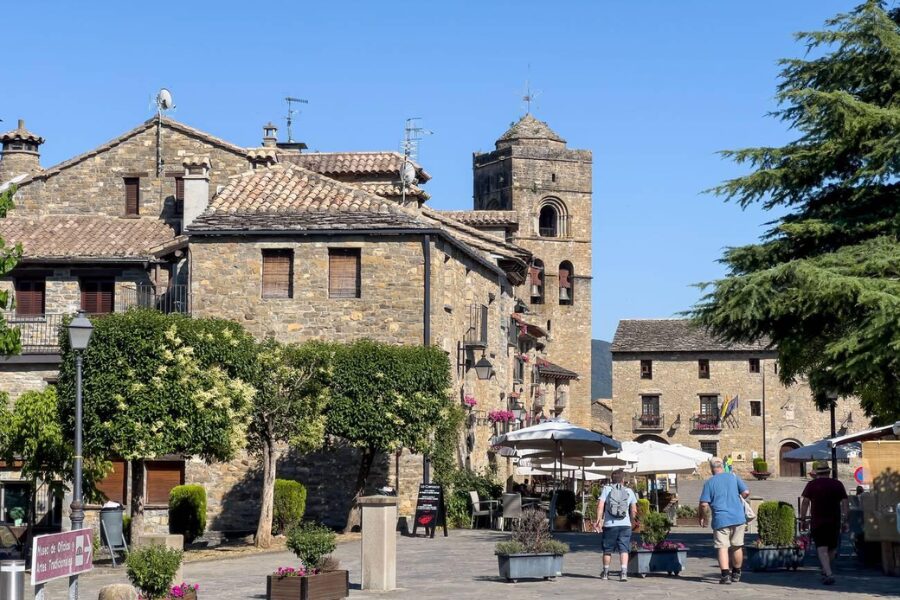
The Castle of Aínsa and Church of Santa Maria anchor the village’s historic core. When I explored these places, I got a glimpse into the days when Aínsa played a big role in the Reconquest of Aragon. Plaques and small museums helped me piece together its past without getting lost in too much detail.
Must-See Historical Spots:
- Plaza Mayor
- Castle of Aínsa
- Church of Santa Maria
The Ancient Hilltop Setting
Aínsa’s hilltop spot really sets it apart. The old town rises above the modern village, wrapped in stone walls and overlooking where the Cinca and Ara rivers meet. Up here, the air feels fresher, and the views just don’t quit.
The climb to the top took some effort, but wow, it paid off. From the walls and narrow lanes, I could see patchwork fields and forests spread out below. When the sun set, the stone buildings glowed gold.
Because of its height, the village avoided floods and attacks for centuries. Staying here, I got why people picked this spot to build a fortress and a community that still stands strong.
The Allure of Beautiful Scenery
Aínsa isn’t only about history—nature is everywhere. Right outside the walls, the land rolls into the Pyrenees’ foothills, full of forests and mountain views.
I spent mornings watching sunlight pour over the rooftops, with distant peaks as a backdrop. The Ordesa and Monte Perdido National Park sits close by for hiking, spotting wildlife, or just a picnic.
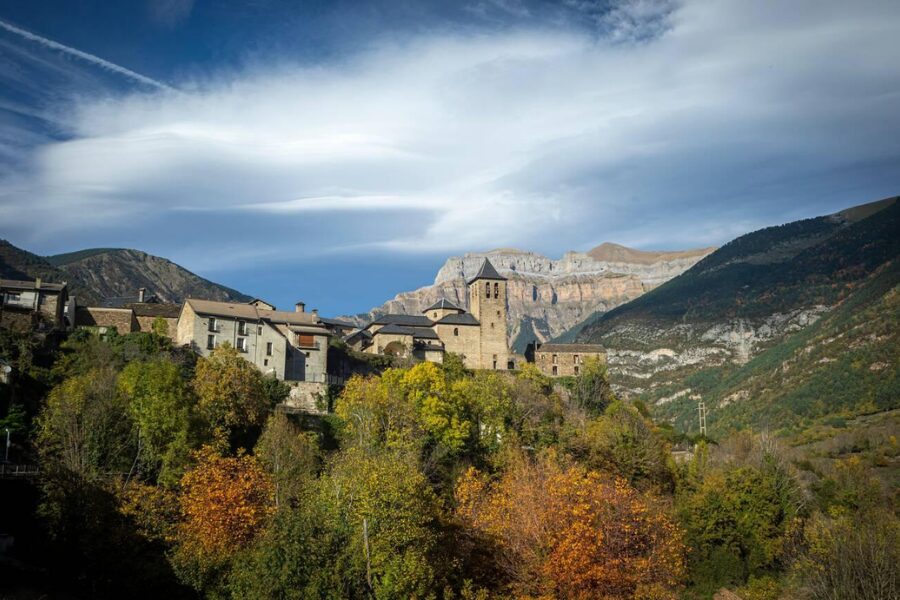
When I needed a break from the old town, I’d wander down to the Cinca or Ara riverbanks. The mountain air and peaceful sounds made Aínsa perfect for anyone who loves nature as much as medieval vibes.
Nature Highlights Around Aínsa:
| Scenery | Activities |
|---|---|
| Pyrenees Mountain Views | Hiking, Photography |
| Riverbanks | Picnicking, Strolling |
| Forest Trails | Birdwatching, Biking |
Plaza Mayor: Historical Heartbeat of Aínsa
Standing in Aínsa’s Plaza Mayor, I felt every stone and archway holding centuries of stories. This big, open square mixes medieval architecture, lively gatherings, and artisan crafts in one unforgettable spot.
Main Square Architecture and Atmosphere
Plaza Mayor sits right in the heart of old Aínsa, its cobblestones stretching wide. Two sides of the square are lined with arched stone porticoes, making shaded walkways that feel straight out of a storybook.
The buildings mix rustic stone and wooden balconies, with symbols carved into lintels above the doors. Most of these places date back to the Middle Ages, and their walls have seen a lot. The square’s open layout lets you catch glimpses of the Pyrenees above the rooftops.
What really got me was the sense of space and light here. Unlike packed city centers, this plaza feels easygoing. On sunny days, locals and travelers hang out on benches, soaking in the details of the old façades.
Vibrant Community Life
The Plaza Mayor isn’t just a pretty face. It’s the living center of daily life in Aínsa. Pretty much any time, I’d see kids playing tag around the fountain, friends laughing in the shade, and older neighbors swapping stories by the church steps.
Markets still pop up here, just like in the old days. When I visited, stalls filled one side of the square, selling local cheese, honey, and veggies. During festivals, Plaza Mayor becomes the main stage for parades and concerts, music bouncing off the stone walls.
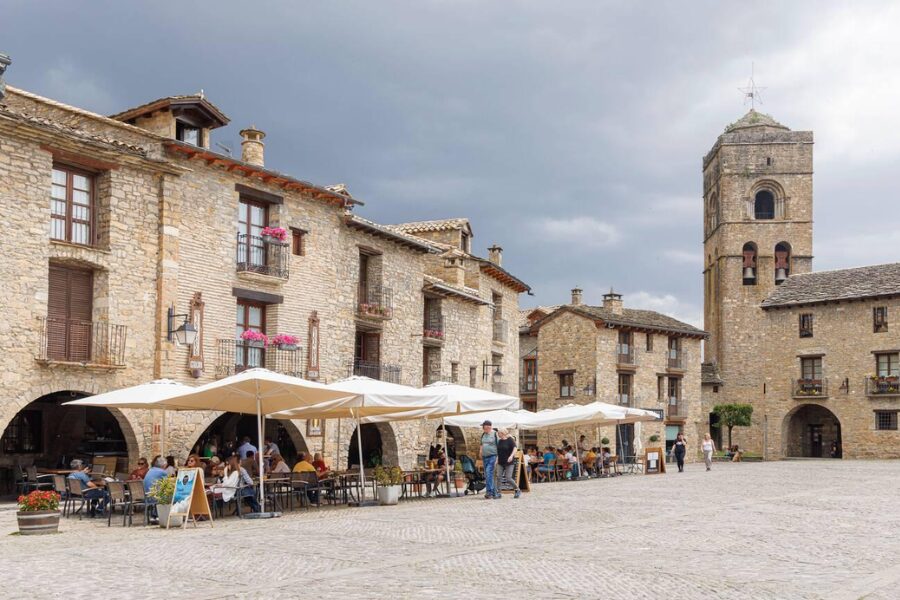
Even during quiet stretches, someone would be chatting or strolling through. The square ties the whole community together, and the traditions here matter just as much as the buildings.
Artisan Shops and Local Art
Tucked under the arcades, I found little shops selling handmade crafts and art. Woodcarvers, ceramicists, and painters showed off their work in tiny boutiques.
I loved browsing Pyrenean wool scarves, pottery with mountain designs, and prints of Aínsa’s landscape. Some artists happily chatted about their craft or gave quick demos. There’s even a gallery or two with local photography and paintings of the village and Ordesa National Park.
Buying here helps local artists and keeps old crafts alive. Every handmade piece felt like a bit of Aínsa’s story I could take home.
Wandering the Cobbled Streets
Aínsa feels like a living museum, but with a gentle hum of daily life. Each street and stone in the old town shows off its medieval soul while welcoming visitors.
Hidden Corners and Timeless Charm
As I wandered the winding cobbled streets, every turn seemed to reveal something new. Some corners hid quiet archways with flowers or weathered wooden doors that looked like they’d kept secrets for centuries.
The air often smelled of fresh bread from local bakeries, making it tough to resist a quick snack. Small shops and cafés blended right into the stone houses.

I found shady benches under leafy trees—perfect for a break and some people-watching. Locals greeted me with a smile, sometimes sharing a story or a tip about their favorite spots. If you’re curious about the history behind each building, a guided tour helps you catch those easy-to-miss details.
Here’s what stuck with me:
- Sloping alleys lined with flower pots
- Stone stairways leading to viewpoints
- Painted wooden balconies on old homes
Every path had its own charm, so each walk felt a little different.
Medieval Heritage Sites
Aínsa’s historic sites cluster right along those cobbled streets. At the center, the grand Plaza Mayor draws everyone in with its wide stone plaza and arcades. The place looks even more magical in late afternoon, when the light softens and the old walls seem to glow.
I headed up to the Castle of Aínsa, still standing tall over the village. Inside, I wandered the old towers and took in sweeping views of the mountains and valley. The Romanesque tower of Santa María Church rises nearby, its simple lines a quiet reminder of medieval faith.
Quick tip: Look for the small signs or plaques at heritage spots—they usually come in several languages and tell the story. Guided tours often kick off in the main square, usually early to avoid the crowds.
| Highlight | What Makes it Special |
|---|---|
| Plaza Mayor | Stunning piazza, lively atmosphere |
| Castle of Aínsa | Panoramic views, history inside walls |
| Santa María Church | Romanesque tower, peaceful setting |
Each site left me feeling like I’d brushed up against the past, with the cobbles under my feet guiding me along.
A Taste of Aínsa: Food, Drink, and Relaxed Evenings
Dinner in Aínsa is more than just eating. The village’s food, drinks, and laid-back nightlife invite you to slow down, taste local flavors, and enjoy the medieval streets as day turns to night.
Bars and Restaurants Experience
Most evenings, I’d start on the stone plaza, where cozy restaurants and bars hug the edges. Many spots are tucked inside centuries-old buildings, with thick stone walls and wooden beams overhead. Sitting outside, I’d catch the soft hum of conversation and the occasional clink of glasses.
Menus offer plenty of variety. Bar Restaurante Fes has been around for over 25 years and serves up traditional Aragonese dishes like roast lamb and migas. Other places mix things up with grilled trout from local rivers or veggie cocidos.
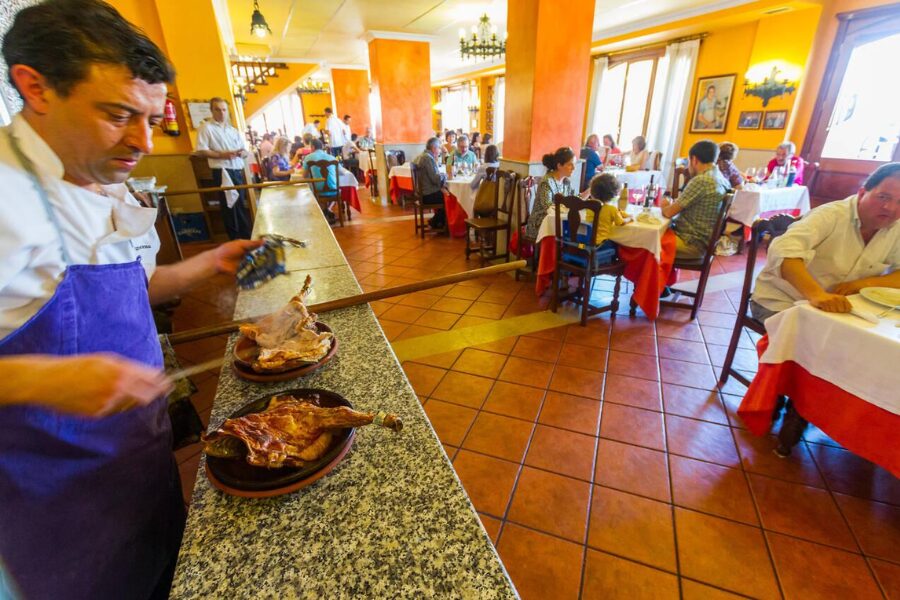
Service here feels warm and unhurried. You can linger over your meal, just watching life unfold around you. No one rushes you out—if anything, you feel encouraged to enjoy every bite and moment.
Enjoying Tapas and Aperitifs
Before dinner, I’d usually join locals at a bar for an aperitif. Vermouth is especially popular, either straight or with soda. Bowls of olives often appeared on the counter, sometimes with slices of chorizo or local cheese.
Tapas are a simple pleasure here. Small plates—cured ham, manchego, tortilla—make a light meal if you want. The tradition is to try several, usually with friends, tasting a bit of everything as laughter spills out into the street.
I always asked about the daily special. One night, I tried pimientos rellenos (stuffed peppers) and immediately wanted more. Each bar seems to have its own favorites, so exploring is half the fun.
Entertainment and Nightlife
Nights in Aínsa are relaxed but never boring. After dinner, people stroll through the glowing streets or gather at outdoor tables. Many bars keep serving late, especially on weekends or festival nights.
You won’t find wild clubs here, but the mood is social and welcoming. Sometimes there’s live music—maybe a folk band or a guitarist in the plaza. Those little moments pull everyone together, locals and visitors alike.
Evenings usually end with good conversation and maybe a nightcap of local herbal liqueur. I found the mellow pace just right for unwinding after a day out, with enough going on to keep things interesting.
Exploring Beyond Aínsa: Connections and Travel Insights
Aínsa isn’t just a destination—it’s a gateway. From its stone arches, I found the Pyrenees calling and routes stretching south, leading me back toward Madrid.
Venturing Into the Pyrenees
Leaving Aínsa, the Pyrenees just shoot up almost right away. Their green valleys and rocky peaks never really leave your sight.
I drove north one afternoon toward Ordesa y Monte Perdido National Park. It’s less than an hour away, which makes it pretty tempting for a quick day trip.
You can head out for a hike or just breathe in that wild mountain air. Either way, it feels good to get out there.
For the best views, I stuck to some well-marked walking trails starting near Torla. That mountain town honestly feels like time forgot about it.
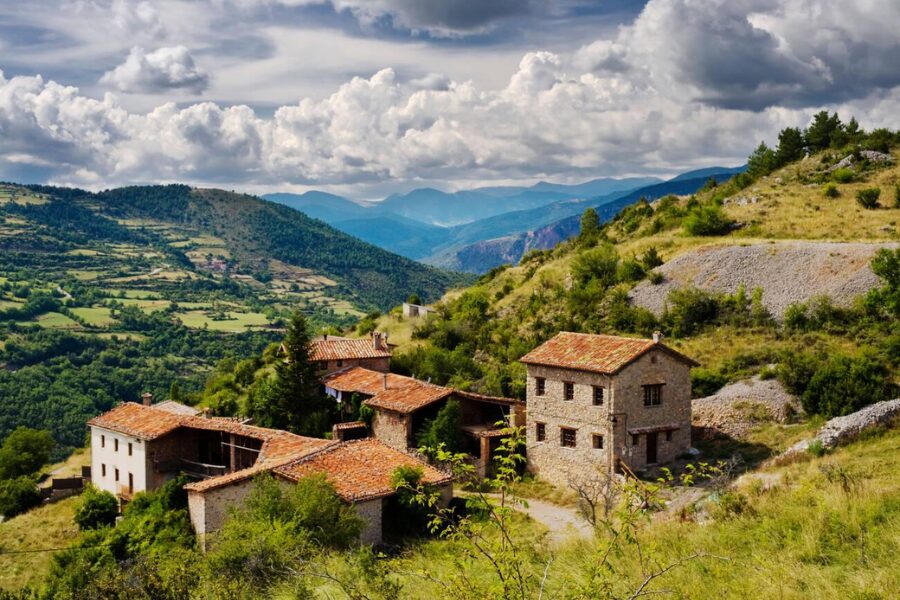
Bring sturdy shoes and a couple of layers. The weather up high changes before you know it.
Watching eagles glide over those quiet valleys—yeah, it hit me how unique this little slice of Aragon is.
If you’ve got a bit more time, here’s a quick table of highlights I found handy:
| Nearby Spot | Distance from Aínsa | Why Visit? |
|---|---|---|
| Torla | 33 km | Trailheads, mountain charm |
| Bielsa | 38 km | Tunnel, French border |
| Ordesa Park | 40 km | Dramatic landscapes |
Journeying from Madrid
Traveling from Madrid to Aínsa felt exciting, honestly. The trip covers about 450 kilometers, and it usually takes a little over five hours if you’re driving.
I decided to drive so I could stop in Zaragoza or Huesca. Both towns offer lively plazas and pretty great tapas—definitely worth a quick detour.
You can’t catch a direct train to Aínsa, so you’ll need to go by car or bus. Buses connect from Zaragoza or Huesca and link the bigger cities to these quiet mountain towns.
I rented a car, and I have to say, having that freedom made the trip better. I could pull over at any scenic spot, take my time, and not worry about a schedule.
If you’re heading out from Madrid, here’s what I’d keep in mind:
- Best travel window: Spring and fall—mild weather, fewer crowds
- Highway tip: Take the A-2 and then N-260 for scenic driving
- Packing: Bring layers for the mountain air, plus a camera for those rural views
When I finally rolled into Aínsa after the long drive, I noticed the difference right away. The pace just slows down, and you can actually feel the history in the air. Totally worth it.

